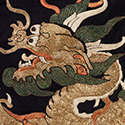|
|
| Show All 54 Results (Text Only) |
|
| The Artful Fabric of Collecting |
|
| Jordan Schnitzner Museum of Art, University of Oregon
|
Chinese textiles from the collection of Gertrude Bass Warner (1863-1951), who… was particularly drawn to silk textiles and the people who produced them, primarily the women in private households and commercial workshops. Techniques and patterns of weaving silk for Chinese robes are demonstrated on the site. It was only in the 17th century when the production of court orders began to overwhelm the imperial workshops that commercial workshops took over some of the production. In these commercial workshops, most of them located in the Jiangnan area, the center of China’s silk production, male weavers relegated women to the groundworks of silk production: the rearing of the silkworms and reeling the silk of the cocoons. Embroidery remained the domain of women. They were the master embroiderers who developed the art to its height in the Qing Dynasty (1644-1911). Their legacy can be admired in the textiles from the Warner collection.
Go to Museum Resource: https://glam.uoregon.edu/s/fabric-of-collecting/page/welcome | |
|
|
|
| Asian Influences on European Art |
|
| Getty Museum
|
Explore with your class Asian influences on European art in the 18th century in this lesson plan. Discover ways to engage your students in the investigation of chinoiserie, the cultural and artistic trend that produced objects and paintings reflecting Chinese subjects and motifs. In its broadest sense, chinoiserie was meant to evoke the spirit and decorative forms of faraway lands as diverse as China, Japan, India, and the Middle East.
Go to Museum Resource: http://www.getty.edu/education/teachers/classroom_resources/curricula/asian_inf... | |
|
|
| The Astor Chinese Garden Court |
|
| The Metropolitan Museum of Art
|
A replica of a Ming dynasty home garden from Suzhou, China, recreated by artisans from China. The design of the museum's Chinese garden is "based on a small courtyard within a scholar's garden in the city of Suzhou, China, called Wang Shi Yuan, the Garden of the Master of the Fishing Nets.The first permanent cultural exchange between the U.S. and the People's Republic of China, the installation was completed in 1981. Conceived by museum trustee Brooke Astor, the courtyard was created and assembled by expert craftsmen from China using traditional methods, materials and hand tools." See photo gallery as well as lesson plan.
Go to Museum Resource: https://www.metmuseum.org/art/collection/search/78870 | |
|
|
| China on Paper: European and Chinese Works from the Late Sixteenth to the Early Nineteenth Century |
|
| Getty Museum
|
Online presentation of a 2007-08 exhibition presenting "works on paper from the special collections of the Research Library at the Getty Research Institute that document the fascinating story of cultural exchanges between Chinese and Europeans in the early-modern era." With text discussing the key role that Jesuit missionaries in China played in the story of this exchange, illustrated with six works from the exhibition.
Go to Museum Resource: http://www.getty.edu/art/exhibitions/china_paper/ | |
|
|
| China’s ‘China’: Porcelain’s Contribution to World History and Culture |
|
| China Institute
|
A simple and clear-cut way of demonstrating the significant impact that Chinese porcelain has had on global material culture over many centuries is to consider the very word ‘China’ in the English language: the word refers not only to the country but is also synonymous with the porcelain pottery ware that began to circulate in Europe almost as soon as European ships rounded the Cape of Good Hope and increasingly established direct trade relations with China and other Asian countries. Ceramic pottery is, of course, as old as human civilization and found around the globe; but the unique quality and properties of porcelain—its considerable strength, translucency, and high resistance to thermal shock—make it one of the great contributions Chinese civilization has made to world cultures.
Go to Museum Resource: https://china360online.org/?property=appreciation-capitals | |
|
|
| Chinese Calligraphy |
|
| The Metropolitan Museum of Art
|
An overview of the development of calligraphy in China: "Calligraphy, or the art of writing, was the visual art form prized above all others in traditional China. The genres of painting and calligraphy emerged simultaneously, sharing identical tools—namely, brush and ink. Yet calligraphy was revered as a fine art long before painting; indeed, it was not until the Song dynasty, when painting became closely allied with calligraphy in aim, form, and technique, that painting shed its status as mere craft and joined the higher ranks of the fine arts. With images of 16 paintings from the Song, Ming, and Qing dynasties and two related objects.
Go to Museum Resource: http://www.metmuseum.org/toah/hd/chcl/hd_chcl.htm | |
|
|
|
|
| Show All 54 Results (Text Only) |









